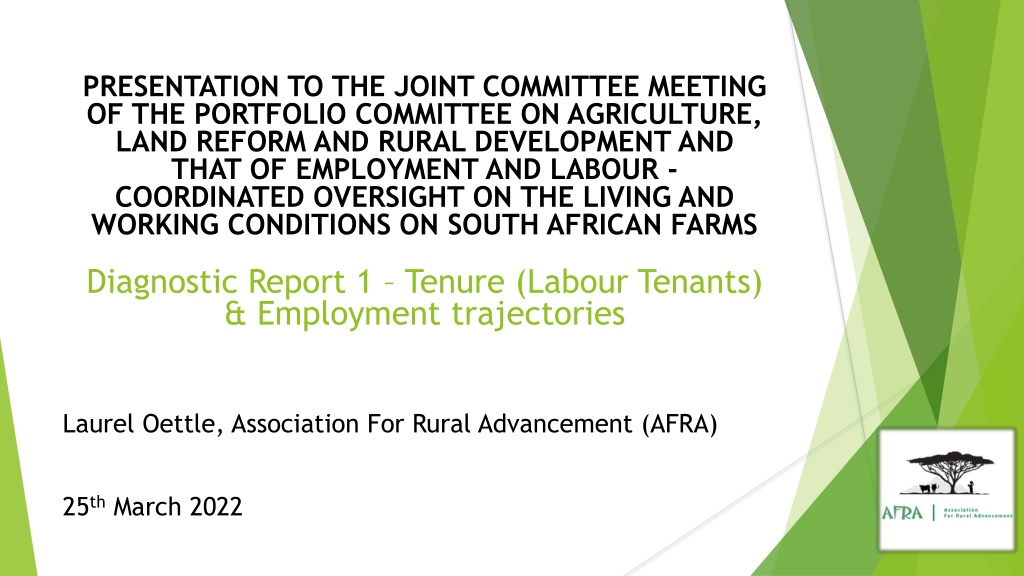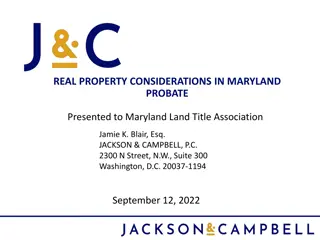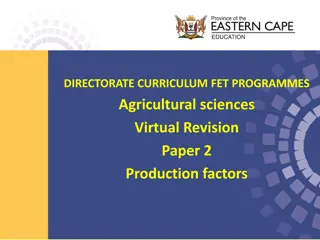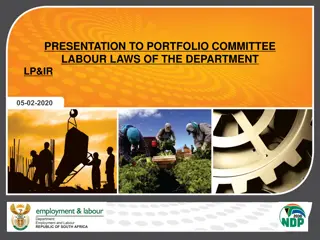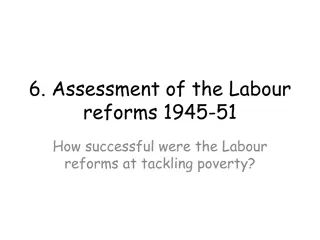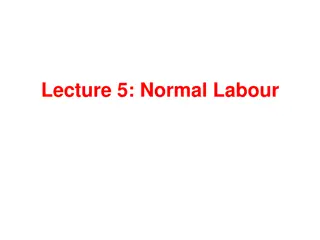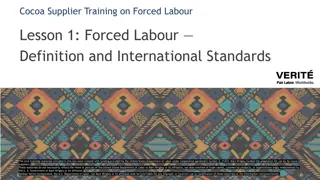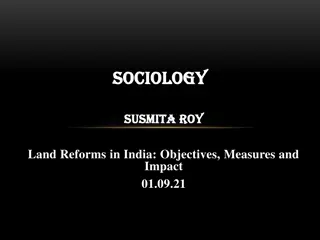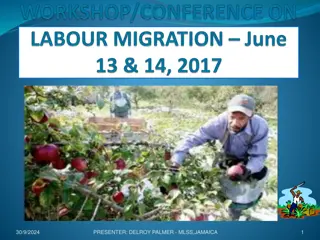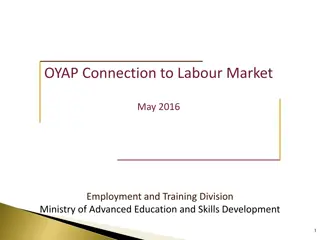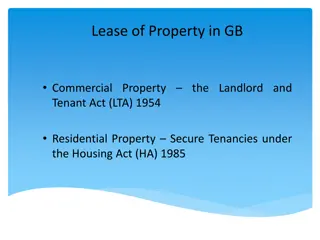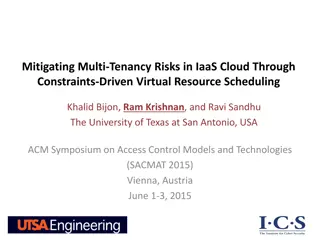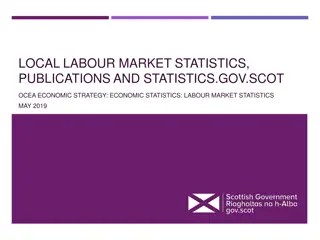Evolution of Labour Tenancy: Historical Perspectives and Current Realities
Labour tenancy in South Africa has a complex history, shaped by contested perspectives on land tenure and power dynamics between commercial farmers and labour tenants. Originating in survival competition, labour tenancy faced challenges during apartheid and continues to evolve today, impacting living and working conditions on South African farms.
Download Presentation

Please find below an Image/Link to download the presentation.
The content on the website is provided AS IS for your information and personal use only. It may not be sold, licensed, or shared on other websites without obtaining consent from the author. Download presentation by click this link. If you encounter any issues during the download, it is possible that the publisher has removed the file from their server.
E N D
Presentation Transcript
PRESENTATION TO THE JOINT COMMITTEE MEETING OF THE PORTFOLIO COMMITTEE ON AGRICULTURE, LAND REFORM AND RURAL DEVELOPMENT AND THAT OF EMPLOYMENT AND LABOUR - COORDINATED OVERSIGHT ON THE LIVING AND WORKING CONDITIONS ON SOUTH AFRICAN FARMS Diagnostic Report 1 Tenure (Labour Tenants) & Employment trajectories Laurel Oettle, Association For Rural Advancement (AFRA) 25th March 2022
Diagnostic Report on the Tenure Security of Labour Tenants in South Africa, was commissioned report for High Level Panel on the assessment of key legislation and the acceleration of fundamental change, an initiative of the Parliament of South Africa Co-authored with Dr Donna Hornby, and Michael Cowling in June 2017 HLP Research and finding seem to have ben largely ignored, with new processes started, so this is welcome.
Much has changed since 2017: while the history remains the same, the current and future trajectories are in a very different and critical place for labour tenants.
1. History Labour tenancy discourse is historically and currently complex and controversial Contesting perspectives on land tenure and meaning of land, rights, duties & power Commercial farmers (owners Roman Dutch Law; title deeds) Labour tenants and farm dwellers (occupying, usually for generations - often see themselves as true owners) Labour tenancy Labour tenant defined: Those who have historically worked the land in return for the right to occupy the land on which they lived, as well as grazing and cropping rights. a continuum in which boundaries become increasingly blurred as one nears the centre. Donna Hornby.
History contd. Origins of labour tenancy: competing for survival; land & labour linked Unequal power relations: uneven competition for land white farms vs. African Loss / absence of political power = most labour tenants existed on basic subsistence Absence of tenure security: virtually no protection against arbitrary evictions
Labour tenancy during apartheid and today Labour tenancy under pressure in the 1950s from Apartheid Government Attempted abolishment for number of reasons, e.g. not providing sufficient labour (increasing commercialisation) not addressing land shortages of African tenants. Probably also wanted to move surplus tenants to homelands as per Apartheid policy Nel Commission of Enquiry (1961): recommended abolition as out-dated; replacement with waged labour
1964: Bantu Laws Amendment Act: sought to speed up transition to wage labour Failed due to continued need for cheap labour on farms (esp. less modernised farms), but lead to increased vulnerability and exploitation for labour tenants Standard contract no longer applied; farmers made own rules & conditions evict in dissatisfied; could refuse cropping & grazing rights End of 1980s, AFRA research estimated that there were around 500,000 labour tenants despite abolishment, mainly KZN & Mpumalanga this Provincial differentiation is N.B. Enabled some access to agricultural land, multiple livelihoods
2. Background of the Labour Tenants Act Perspectives on the Land Reform (Labour Tenants) Act 3 of 1996 Opposed by organised agriculture the South African Agricultural Union (SAAU) and Natal Agricultural Union (NAU) Landowners' property rights Contravened Gov. promise that title deeds of farmers would be safe Civil society perspectives Not controversial enough 2nd June 1995 cut-off date for those evicted disputed Too complex and alienating language for stakeholders Post-enactment neither parties satisfied, effective communication & implementation plan was lacking, and uncertainty prevailed.
3. Content of the Land Reform (Labour Tenants) Act 3 of 1996 Purpose to protect the current occupational rights of labour tenants, which include land use, as vested on 2nd June 1995 Three-fold definition of labour tenant: Such person must have the right to reside on a farm (i.e. agricultural land as defined in terms of the Subdivision of Agricultural Land Act 70 of 1970); Such person must have enjoyed cropping and grazing rights on that farm or another farm of the landowner and has provided labour in consideration of such rights; Whose parents or grandparents were labour tenants.
Eviction prohibited without legal consultation and Court permission. Must be just and equitable Offences illegal eviction may lead to fine or two years in prison Key aspect: acquisition of land ownership Section 16 provided labour tenants with an opportunity to lodge claims to own land they are entitled to occupy or use in terms of the Act. Application period ended 31st March 2001. Important: no agreement (bet. tenant & landowner) in which tenant waives rights to acquire land allowed unless DG satisfied tenant had full knowledge of nature & extent of rights & consequences of waiving rights
4. Problems Arising from the Act The Land Claims Court (LCC) Rights-based approach of Act operationalised in LCC: custodian of rights & protections of Act Challenges to ensure fairness and justice due to formalistic approach: survey: technicalities become overriding factors Criticised for delays, escalating costs, challenge of securing court dates, venues and access from rural areas Two-phased application process (first for tenant status, then acquisition of land) obstacle to effectiveness Act adversarial in nature: triggered by lodging of claims Alternative approaches to dispute resolution (arbitration & mediation) have been referenced extensively in Act but not implemented. CCMA model useful.
Defining labour tenant Triangle of rights of occupation, use and enjoyment Two conflicting approaches & contradictory judgements in LCC: a broad (two criteria), and a narrow (all three criteria) definition of labour tenant as set out in the Act: The narrow definition criticised for exlusive inclusion, and as such contradicts the objectives of the Act; And potential of ambiguous interpretations - wording is obscure Labour tenant vs farm worker the potential pitfalls of categorisation & conversion; exclusion if defined as worker
Impact on evictions Implementation of the Act should have resulted in major reductions in evictions The legal provisions in the Act firmly protect labour tenants from arbitrary evictions Despite protections, it does not appear to have made positive impact in practice According to a study conducted by Nkuzi Development Association 940 000 rural dwellers were evicted between 1994 and 2003, only 1% of which were legal. Rigid definition of labour tenant contributes to 'legality' but increases tenure insecurity
Lack of implementation Probably the greatest cause for lack of adequate protection of tenure security and other labour tenant rights Director-General of the Department mandated the role of facilitator and mediator between claimant and landowner, and as such bears the responsibility of implementing the Act The Department states many labour tenants have been dealt with through other policy programmes PLAS, SLAG, LRAD, etc. but concern over rights being diminished and lack of records Shortcomings: Policy-oriented vs rights-based approach
5. Constitutional aspects of the Act Contradiction of rights in Section 25 of the Bill of Rights in the Constitution: right to property as fundamental right. Property clause recognised as 'two-spronged' mechanism to 25(1): Land owners: protection from deprivation of property; 25 (6): Tenants: tenure of land legally insecure due to discriminatory laws & practices entitled to secure tenure or suitable redress A labour tenant claim in accordance to the Labour Tenants Act illustrates these tensions Violation of constitutional obligations in failing to implement the Act
6. Labour Tenant Class Action Legal Case Mwelase and others vs. The Director-General for the Department of Rural Development and Land Reform, Case Number 107/2013 Applicants: Bhekindlela Mwelse, Jabu Agness Mwelase N.O.; Mndeni Sikhakhane; Bazibile Gretta Mngoma N.O.; Association For Rural Advancement. Respondents: The Director-General for the Department of Rural Development and Land Reform; Minister of Rural Development and Land Reform; The Hiltonian Society Nature of Case: Class Action on behalf of labour tenants to set legal grounds for the DRDLR to implement the Land Reform (Labour Tenants) Act. of 1996.
Background Thousands of the 22,000 applications lodged by labour tenants before the cut-off date of the 31st March 2001 remained unprocessed 15 years later. This is currently estimated as 9,000 unresolved claims, noting that one claim is made for a family, not an individual. Claimants and farmers stuck in limbo of increased uncertainty and insecurity due to delays in the LCC First court hearing 19th Sep 2014 DRDLR unilaterally stated policy trumps rights by not processing individual labour tenant claims due to efficiency & cost: PLAS predominant mechanism. Long and complex legal process since then, through the High Court of Appeals and finally the Constitutional Court.
Current status Applicants argued successfully for the appointment of a Special Master for Labour Tenants (SMLT) to address the challenges. This would be an independent person appointed by, & reporting to, the Court to assist implementation of a complex order. Dept. & Minister made renewed commitment to labour tenants & starting to take actions & invest, but the challenge is enormous. They are now working closely with the SMLT.
Special Master of Labour Tenants (SMLT) appointed as per the Constitutional Court Judgement: Not an advocate for the claimants or Government, but agent of the court. A problem solver, a solution finder Arguably providing the surest route to the relief sought: full implementation of the Act and secure tenure for those whose claims are upheld in accordance with the criteria laid down by the legislation. SMLT states that his office seeks social impact investors and other partners to support the resolution of long outstanding labour tenants' land claims across South Africa.
7. What have been the unintended consequences of the Land Reform (Labour Tenants) Act? On-farm conflicts between claimants and landowner, the latter in superior position in terms of resources & power Increased numbers of evictions post-1994 - not the primary cause, but failure of implementation has failed to protect Commercial farming groups argued the Act created poverty traps The uniquely prescriptive nature of the Act on undermining the possibility of labour tenants making successful land claims when conflict or obstacles arise
8. Can implementation of the Land Reform (Labour Tenants) Act help address rural poverty, unemployment and spatial inequality? If alternative implementation models adopted, strong evidence it can help address rural poverty and spatial inequality as intended: The NDP identifies small-scale farming development as key driver for rural employment and rural economic development. Labour tenants have generations of skills and success at smale-scale farming. Redistribution of white-owned commercial farmland to black small-scale famers to drive agrarian transformation.
9. Recommendations Parliamentary oversight of ensuring the DALLRD full implementation of the Labour Tenants Act: With effective budget allocations to the Office of the Special Master (OSM) and the Provincial-level DALLRD Offices (many of which remain dysfunctional) to fully implement the current Court- Approved Labour Tenant Claims Resolution Project. The OSM has made proposals to ENABLE LAND REFORM TO BE AN OPPORTUNITY TO CREATE RURAL EMPLOYMENT & SUSTAINABLE FARMING COMMUNITIES these are worth engaging with. Cross-Departmental and multi-stakeholder spaces are critical for this, at both local, District and National Level. Support the DALLRD and Civil Society to revive the Multi- Stakeholder Platform on Land Governance that was committed to in 2017. There is much discussion of Social Compacts , but we need to see mechanisms to create this in action.
Recommendations contd. Strong support for fast-tracking effective Alternative Dispute Resolution Mechanisms - that are available in law and policy, but under-utilized - to speed up change processes while building positive relationships that can lead to: Better rural safely and a reduction in crime on farms; Improved and more diverse forms of agriculture, which will not only increase food security but climate change adaptation capacities and resilience against future shocks such as COVID-19 and the July 2021 unrest. Increased employment opportunities as labour tenants become land owners and farmers. This will required effective capacity building, infrastructure development and post-settlement support.
Recommendations contd. Appropriate resource allocation shrinking land reform budgets in real terms will not allow land reform to move forward effectively. The speeding up of creating an effective and inclusive Land Administration and Records system that supports what are currently off-register rights. Work is being done on this, but there needs to be a more inclusive approach to joint working other stakeholders. Create an enabling environment for land donations from farmers.
